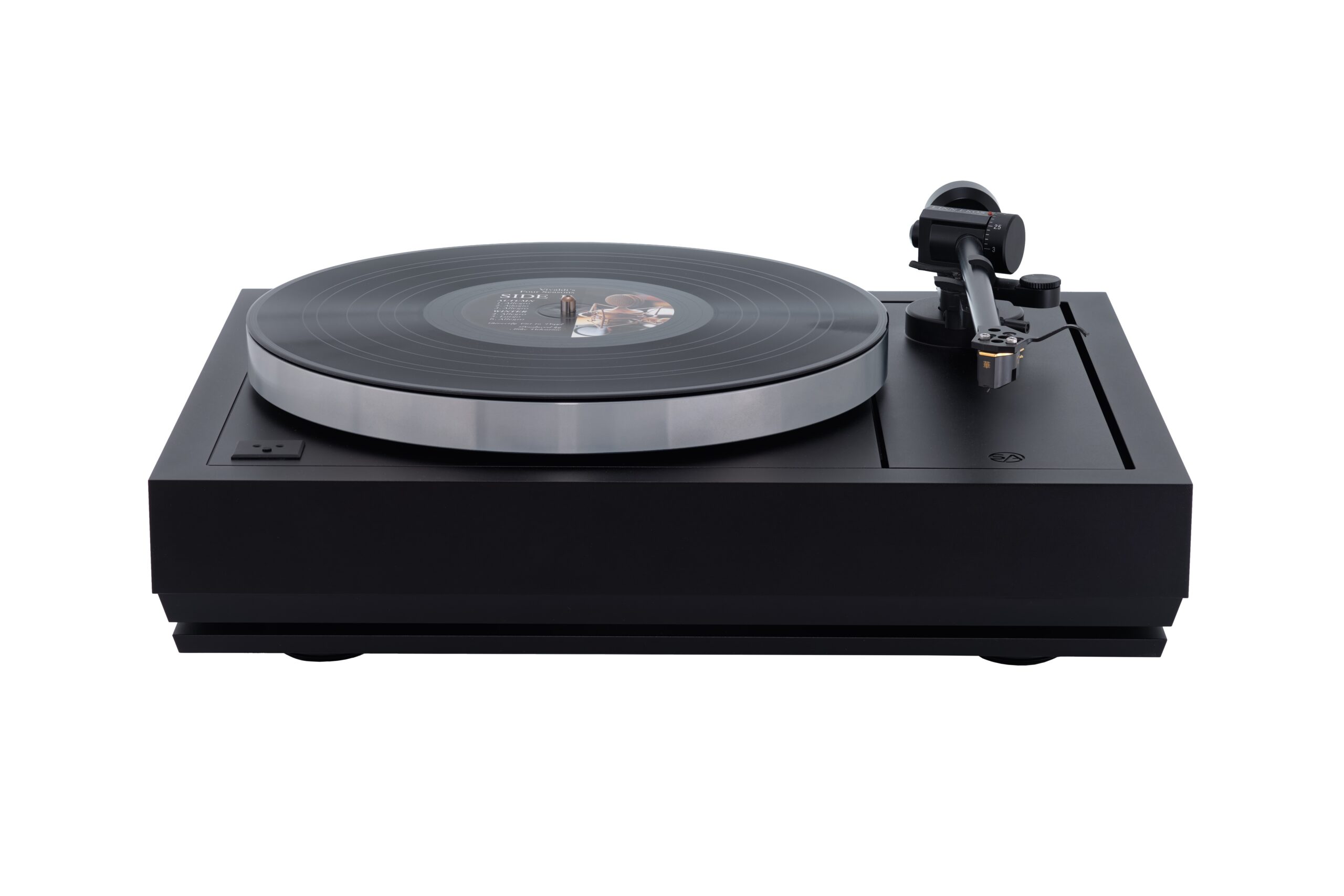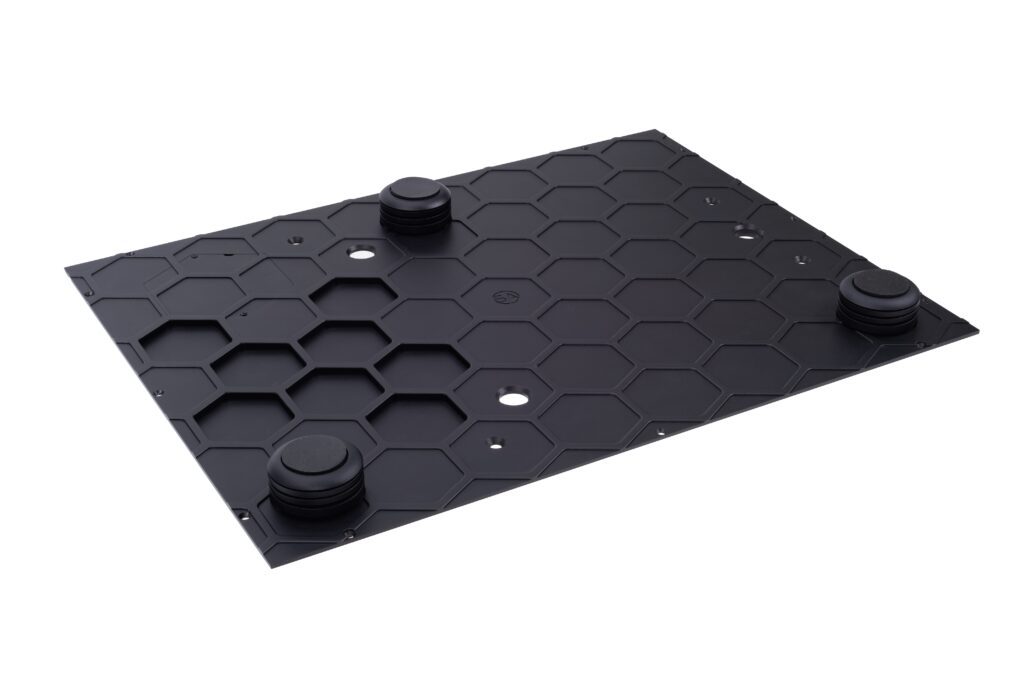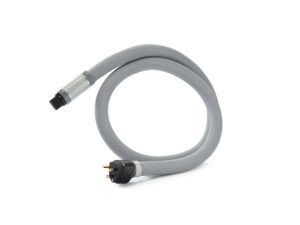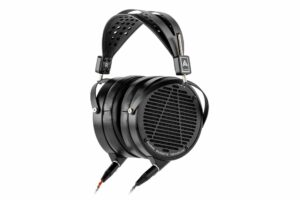
Theo Stack is an obsessive about detail, the all-in-one plinth for the Soprano he brought for review was not good enough to be sold because one of the corners wasn’t sharp enough, apparently. I could just about feel what he meant but couldn’t see the problem. He feels that if you are going to sell a product at this price it has to be perfect and he’s right, but he’s more of a perfectionist than many. Theo started out by teaching himself how to design on the computer using CAD and all of the Stack products from the Onset streamer he started out with through the Link II streamer that went into production and now the Serene LP12 upgrades that he’s concentrating on have featured superbly machined and finished metalwork.
There are three levels of Serene LP12 upgrade and Soprano is the best of them, it replaces all the structural elements of the turntable and leaves only the motor, bearing, springs, sub platter, platter, arm and electronics from the original Linn. The entry level Tenor system uses stainless steel and acrylic parts while the mid point Alto sees the introduction of machined aluminium parts featuring a honeycomb latticework to give them structural integrity with minimal weight. With Soprano, however, even the plinth is machined from aluminium – a single billet, at that – so you can imagine how stiff and strong it is.

The critical armboard and subchassis are machined from a single piece too, but here the weight has to match that of the original pressed steel subchassis and wooden armboard of the original so it had to be kept down. The problem with taking so much metal away is that it makes it very likely that the component will warp during the machining and anodising processes, so it’s critical that the job is done with very high precision. It probably isn’t obvious from the pictures but the hexagonal cells are of varying depth; this varies the weight in each cell and maintains the correct centre of balance for the subchassis. You might also be able to spot that some of the hexagon bases have a slightly different finish, this is a constrained layer damping system that Stack calls AVDC. What is not apparent is that the most critical parts of both the subchassis/armboard and the plinth incorporate a proprietary vibration dissipation system, about which Stack remains very tight lipped; a patent application is underway.
There are a number of companies making aftermarket components for the LP12; it is an iconic turntable that has been on the market for going on 50 years so there are plenty of them out there. Most use aluminium to replace key elements, an approach that Linn has also followed, so it’s not a radical approach. Making a complete plinth in this material is unusual though; there is one other example on the market but at a significantly higher price. A one-piece aluminium plinth and top plate brings a degree of solidity to this turntable that is extreme but the precision it results in and the way it behaves undoubtedly have an impact on performance even though this is a suspended design.
Ekos, Rega or ARO
The quality of engineering is only really apparent when you look at the separate elements, many of which are hidden within the plinth; the turntable as a whole looks like a regular LP12. As the bearing, platter, motor etc all come from a donor LP12 the components are the same size as that venerable turntable. The armboard on the review sample had a collar for the Ekos arm machined into it, but Stack will shortly be introducing armboards with (both) Rega mountings as well as one of the Naim ARO which has long been a favourite among dedicated Sondek users.
The two other parts of Soprano are the baseboard (including feet) and a cross-brace, which both feature the AVDC technology to eliminate ringing. Whether such a rigid plinth still requires a cross-brace is open to debate, but this part also supports the power supply for the motor.

I asked Theo Stack what he was trying to achieve with his Serene modifications and he said: “I didn’t want to lose any of the original qualities that the LP12 provides, I aimed to keep the euphoric, rich sound but to add a bit of extra substance to it. Initially, I wasn’t entirely sure what I was searching for, however, when I heard it, I knew immediately that I had begun to achieve what I had set out to.”
Substance and precision
I am not an LP12 owner and never have been, but I’ve heard enough of them to have a reasonable handle on their character and appeal. You’d think that by replacing all of the wood and steel of the original with aluminium that the sound might end up being metallic, yet the methods used to damp and dissipate vibration have been entirely successful in keeping this turntable’s relaxed yet beautifully timed character front and centre. It’s hard to say how Soprano would compare with a modern LP12 but it delivers on Theo’s desire to add substance and precision to the bass in no uncertain terms. I started out with a Dynavector DV-202L cartridge in the Ekos arm but latterly moved to a Transfiguration Proteus, both connected to a Tom Evans Groove+ SRX MkII phono stage. The Stack LP12 was powered by a Lingo 4 power supply and had the Karousel bearing, but the Linn other parts were standard issue.
Despite the wholesale replacement of so many key elements the Soprano still sounds essentially like an LP12, it has that lovely easy groove that makes it so popular and it’s very easy to enjoy all sort of music with. Where the precision metalwork makes itself heard is in the bass which while still warm is firmer and stronger, and this means that all manner of instruments sound more solid and purposeful. Drums have really good attack and weight which means that you get excellent dynamics from a well struck kit, if the recording is good that helps of course but even mainstream releases often have decent drum sound, sometimes very decent indeed. The power of drums is always evident regardless of what’s going on higher up in the mix, and when they are of electronic origin there can be a meaty bodaciousness that gets into your subconscious and makes your body move along with the beat. At least it does when the Prodigy are involved, the track ‘Poison’ [Music For The Jilted Generation, XL] starts with spoken word which is startlingly clear then moves into drum machine beats with a distorted edge for maximum impact, something that comes through loud and clear on bigger speakers. It’s high intensity musical entertainment that’s underpinned by some seriously low bass.
Drilling down
I really like the sense of stability that the Stack Soprano brings to the party; nothing seems to phase it, no matter how complex. It’s a real treat to close your eyes and listen to the many elements within a busy mix being rendered in lifelike fashion. Almost regardless of how quiet a given voice or instrument is it’s possible to follow what they are contributing. This sense of stability also extends to the imaging which is properly rock solid, everything is in its right place to paraphrase Radiohead, and it stays there no matter which way the dynamics swing. This is because the Soprano is also very good on detail, it really drills down into the mix and pulls out the nuances.
Paul Messenger used to play the Grateful Dead on his Naim Armageddon upgraded LP12 and it always had a fabulous groove with precise bass lines, this variation on the theme does the same trick with that most articulate of bands. On Blues for Allah [United Artists} the interplay of the various guitars and keyboard are reproduced in a tremendously insightful manner, it really feels like you’re in the studio control room listening to the sort of monitors they had back in the early ‘70s.
For those who love their LP12s the Stack Soprano package offers a way to increase its resolving powers and solidity in the bass without having to give up what makes this turntable so engaging. The option exists to upgrade one part at a time, starting perhaps with the Sub-Chassis and armboard or to go the whole hog and get the full effect. In LP12 terms the whole hog is very competitively priced and results in a significantly more revealing turntable.
Technical specifications
- Type Upgrade components for the Linn LP12 turntable
- All-in-one Plinth Single piece top plate and plinth machined from aluminium with AVDC technology
- Baseboard Machined aluminium baseboard with AVDC technology
- Subchassis Single piece subchassis and armboard machined from aluminium with AVDC technology
- Cross-brace Machined aluminium cross-brace with AVDC technology
- Dimensions (H×W×D) 140 × 445 × 349mm
- Weight 14kg (complete turntable, arm & cartridge)
- Price Soprano Full Set £6,450
- Soprano Baseboard £1,100
- Soprano Cross brace £140
- Soprano All in one plinth £3,500
- Soprano Sub chassis/armboard £1,850
Manufacturer
Stack Audio
+44(0)1626 249005
By Jason Kennedy
More articles from this authorRead Next From Review
See all
PrimaLuna EVO 100 phono preamplifier
- Apr 22, 2024

Reiki Audio SuperSwitch Master Pro + Servant Pro
- Mar 27, 2024

Melco Audio N1-S38 music server
- Mar 27, 2024











